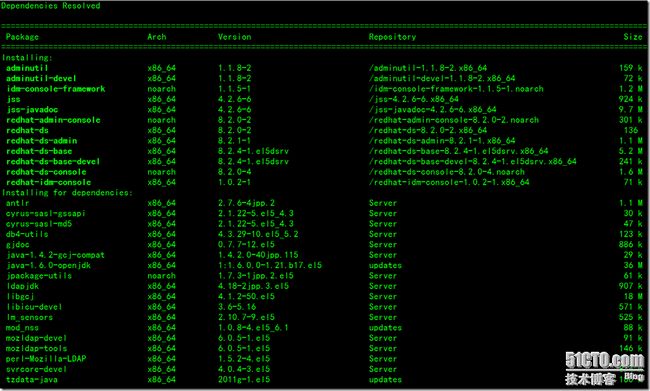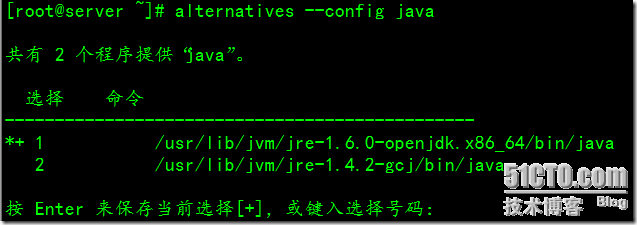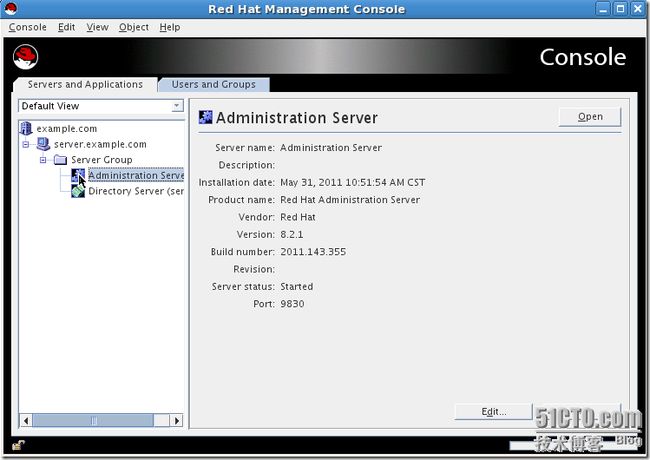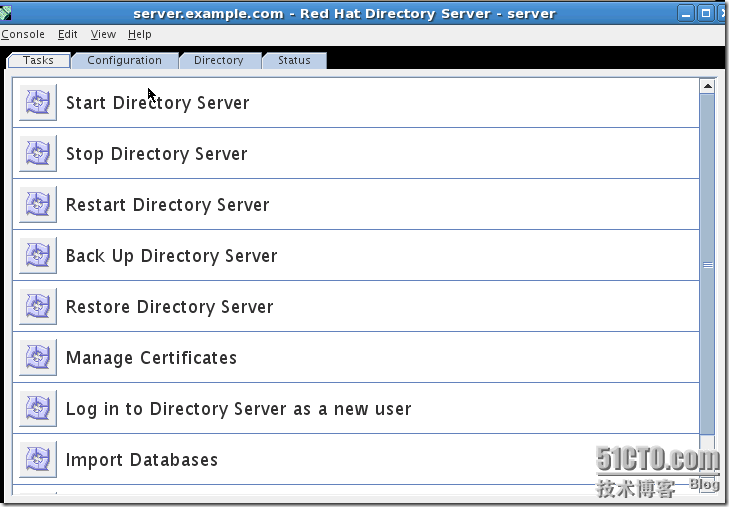RHDS是一套基于openldap的目录服务,当前可在官方下载的最新版本是8.2,不过下载下来的都是源代码rpm软件包,需要编译成二进制rpm软件包。我这里已经编译好了,总共12个软件包,已经包含了依赖的软件包,软件包名称如下图所示:
源代码的下载地址:http://ftp.redhat.com/pub/redhat/linux/enterprise/5Server/en/RHDirServ/SRPMS/
一、安装:
1、软件包的安装:
所有的软件包都放在同一个目录中,所以直接使用yum localinstall命令进行安装,这样有些依赖软件可以自行解决。
rhds在/etc下面的工作目录是/etc/dirsrv文件夹。服务名称是dirsrv,可以使用service进行控制。LDAP的位置是/usr/lib64/mozldap。 如果使用openldap的命令查看rhds信息,必须使用-x参数禁止SASL。
2、RHDS的组件介绍:
三大组件:Directory Server、Directory Server Console、Admin Server。其中Directory Server是核心软件包,Directory Server Console是一个管理用户、组以及其他ldap数据的管理窗口。Admin Server是管理DS的一个管理Agent。
RHDS需要俩个TCP端口,一个是389供Directory Server使用,另一个是9830供Admin Server使用。对于LDAPS(LDAP with SSL),默认的TCP端口是636。
安装完成后,还不能立即启动dirsrv进程,因为还要进行初始化,否则启动是会报错的。rhds的初始化可以使用它提供的setup-ds-admin.pl脚本进行初始化操作。
3、硬件要求:
4、配置redhat linux操作系统,以满足rhds的要求:
<1>、check the current limit for file descriptors:
<2>、编辑/etc/sysctl.conf文件,加入以下内容:
<3>、编辑/etc/security/limits.conf加入以下内容:
![]()
<4>、编辑/etc/pam.d/system-auth,加入以下内容:
![]()
5、重启系统。
6、JAVA程序的配置:
二、初始化配置:
在以上内容全部完成后,就可以执行setup-ds-admin.pl脚本配置RHDS了。配置有三种模式:快速模式、专业模式以及定制模式,我这里使用的是专业模式,详细过程如下所示:
[root@server ~]# setup-ds-admin.pl
==============================================================================
This program will set up the Red Hat Directory and Administration Servers.
It is recommended that you have "root" privilege to set up the software.
Tips for using this program:
- Press "Enter" to choose the default and go to the next screen
- Type "Control-B" then "Enter" to go back to the previous screen
- Type "Control-C" to cancel the setup program
Would you like to continue with set up? [yes]: yes
==============================================================================
BY SETTING UP AND USING THIS SOFTWARE YOU ARE CONSENTING TO BE BOUND BY
AND ARE BECOMING A PARTY TO THE AGREEMENT FOUND IN THE
LICENSE.TXT FILE. IF YOU DO NOT AGREE TO ALL OF THE TERMS
OF THIS AGREEMENT, PLEASE DO NOT SET UP OR USE THIS SOFTWARE.
Do you agree to the license terms? [no]: yes
==============================================================================
Your system has been scanned for potential problems, missing patches,
etc. The following output is a report of the items found that need to
be addressed before running this software in a production
environment.
Red Hat Directory Server system tuning analysis version 10-AUGUST-2007.
NOTICE : System is x86_64-unknown-linux2.6.18-238.9.1.el5 (4 processors).
NOTICE : The net.ipv4.tcp_keepalive_time is set to 7200000 milliseconds
(120 minutes). This may cause temporary server congestion from lost
client connections.
Would you like to continue? [no]: yes
==============================================================================
Choose a setup type:
1. Express
Allows you to quickly set up the servers using the most
common options and pre-defined defaults. Useful for quick
evaluation of the products.
2. Typical
Allows you to specify common defaults and options.
3. Custom
Allows you to specify more advanced options. This is
recommended for experienced server administrators only.
To accept the default shown in brackets, press the Enter key.
Choose a setup type [2]:
==============================================================================
Enter the fully qualified domain name of the computer
on which you're setting up server software. Using the form
Example: eros.example.com.
To accept the default shown in brackets, press the Enter key.
Computer name [server.example.com]:
==============================================================================
The servers must run as a specific user in a specific group.
It is strongly recommended that this user should have no privileges
on the computer (i.e. a non-root user). The setup procedure
will give this user/group some permissions in specific paths/files
to perform server-specific operations.
If you have not yet created a user and group for the servers,
create this user and group using your native operating
system utilities.
System User [nobody]:
System Group [nobody]:
==============================================================================
Server information is stored in the configuration directory server.
This information is used by the console and administration server to
configure and manage your servers. If you have already set up a
configuration directory server, you should register any servers you
set up or create with the configuration server. To do so, the
following information about the configuration server is required: the
fully qualified host name of the form
(default 389), the suffix, the DN and password of a user having
permission to write the configuration information, usually the
configuration directory administrator, and if you are using security
(TLS/SSL). If you are using TLS/SSL, specify the TLS/SSL (LDAPS) port
number (default 636) instead of the regular LDAP port number, and
provide the CA certificate (in PEM/ASCII format).
If you do not yet have a configuration directory server, enter 'No' to
be prompted to set up one.
Do you want to register this software with an existing
configuration directory server? [no]:
==============================================================================
Please enter the administrator ID for the configuration directory
server. This is the ID typically used to log in to the console. You
will also be prompted for the password.
Configuration directory server
administrator ID [admin]:
Password:
Password (confirm):
==============================================================================
The information stored in the configuration directory server can be
separated into different Administration Domains. If you are managing
multiple software releases at the same time, or managing information
about multiple domains, you may use the Administration Domain to keep
them separate.
If you are not using administrative domains, press Enter to select the
default. Otherwise, enter some descriptive, unique name for the
administration domain, such as the name of the organization
responsible for managing the domain.
Administration Domain [example.com]:
==============================================================================
The standard directory server network port number is 389. However, if
you are not logged as the superuser, or port 389 is in use, the
default value will be a random unused port number greater than 1024.
If you want to use port 389, make sure that you are logged in as the
superuser, that port 389 is not in use.
Directory server network port [389]:
==============================================================================
Each instance of a directory server requires a unique identifier.
This identifier is used to name the various
instance specific files and directories in the file system,
as well as for other uses as a server instance identifier.
Directory server identifier [server]:
==============================================================================
The suffix is the root of your directory tree. The suffix must be a valid DN.
It is recommended that you use the dc=domaincomponent suffix convention.
For example, if your domain is example.com,
you should use dc=example,dc=com for your suffix.
Setup will create this initial suffix for you,
but you may have more than one suffix.
Use the directory server utilities to create additional suffixes.
Suffix [dc=example, dc=com]:
==============================================================================
Certain directory server operations require an administrative user.
This user is referred to as the Directory Manager and typically has a
bind Distinguished Name (DN) of cn=Directory Manager.
You will also be prompted for the password for this user. The password must
be at least 8 characters long, and contain no spaces.
Press Control-B or type the word "back", then Enter to back up and start over.
Directory Manager DN [cn=Directory Manager]:
Password:
The password must be at least 8 characters long. Please choose another one.
Password:
Password (confirm):
==============================================================================
The Administration Server is separate from any of your web or application
servers since it listens to a different port and access to it is
restricted.
Pick a port number between 1024 and 65535 to run your Administration
Server on. You should NOT use a port number which you plan to
run a web or application server on, rather, select a number which you
will remember and which will not be used for anything else.
Administration port [9830]:
==============================================================================
The interactive phase is complete. The script will now set up your
servers. Enter No or go Back if you want to change something.
Are you ready to set up your servers? [yes]:
Creating directory server . . .
Your new DS instance 'server' was successfully created.
Creating the configuration directory server . . .
Beginning Admin Server creation . . .
Creating Admin Server files and directories . . .
Updating adm.conf . . .
Updating admpw . . .
Registering admin server with the configuration directory server . . .
Updating adm.conf with information from configuration directory server . . .
Updating the configuration for the httpd engine . . .
Starting admin server . . .
The admin server was successfully started.
Admin server was successfully created, configured, and started.
Exiting . . .
Log file is '/tmp/setupey11zm.log'
当这个脚本执行完成后,Directory Server已经被配置好并且处于运行状态:
1、在console.conf文件中获取admin server的监听端口:
2、使用此端口号访问管理窗口:
输入admin的密码,就可进行访问了。
例如要访问Directory Server,则点击右上角的open即可打开Directory Server的管理界面:
这些都是些图形界面操作,很简单的,多点击几下,多看看就能知道他们的意思。这个的安装部分就这么地简单,后续补充高级应用内容以及管理内容,敬请期待!!!








